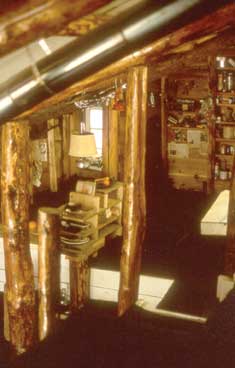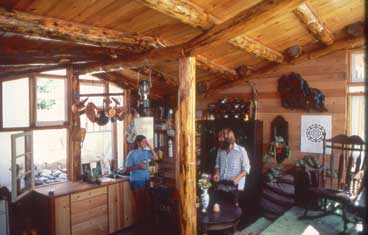
Building underground on the cheap
 Mike Oehler built his first
underground house for $50 in 1971. He used mostly scavenged
materials, which he summed up in a very Thoreau-like table:
Mike Oehler built his first
underground house for $50 in 1971. He used mostly scavenged
materials, which he summed up in a very Thoreau-like table:
- Beams and post - free
- Millends (lumber) - free
- Polyethylene - $15
- Nails - $0.50
- Flooring - free
- Insulation - free
- Paint - $2
- Chairs - free
- Tables - $2.20
- Door - free
- Cooler - free
- Lamp - $4
- Stove, stove pipes, and damper - $22
- Windows - $4
The initial structure
was only 120 square feet, and even though he lived there for four
years, he admits he was on the lecture circuit for three of the four
winters.
In an effort to turn the
structure into a good place to spend a northern Idaho winter, Oehler
added on in 1975 to produce what he calls the $500 house (costing about
$2,000 in today's dollars). The new structure (which includes the
original $50 house) covers 370 square feet across three levels.
In addition to living in the $500 house since 1975, Mike Oehler has
expanded his experience by running an underground-house consulting
business where he designed and/or built several other houses using his
methods. (You can see more photos of the houses he inspired and
built on his website, which is where I found the
pictures in today's post.)
 There's a lot to like about
Oehler's houses, but I want to throw in a few caveats up front (since
you won't find most of these issues mentioned until nearly the end of
his book). The fact his houses won't pass code doesn't really
bother me, but I am much more concerned by Oehler's update about the
parts of his houses that have and haven't failed structurally over the
years --- it sounds like root cellars built using his methods are
problematic, as are non-full-time residences that aren't aired and
warmed on a regular basis. You also should be prepared to put in
huge amounts of labor if you build using Oehler's methods on the cheap
--- his original, 120-square-foot house took about 105 man-hours simply
for the initial excavation. Finally, Oehler admits that you might
need to work harder to keep water out of your underground house if you
live in an area like the Pacific Northwest (or, presumably, here) with
"ridiculous rain."
There's a lot to like about
Oehler's houses, but I want to throw in a few caveats up front (since
you won't find most of these issues mentioned until nearly the end of
his book). The fact his houses won't pass code doesn't really
bother me, but I am much more concerned by Oehler's update about the
parts of his houses that have and haven't failed structurally over the
years --- it sounds like root cellars built using his methods are
problematic, as are non-full-time residences that aren't aired and
warmed on a regular basis. You also should be prepared to put in
huge amounts of labor if you build using Oehler's methods on the cheap
--- his original, 120-square-foot house took about 105 man-hours simply
for the initial excavation. Finally, Oehler admits that you might
need to work harder to keep water out of your underground house if you
live in an area like the Pacific Northwest (or, presumably, here) with
"ridiculous rain."
Stay tuned for
tomorrow's post where I begin to show you what sets Oehler's houses
apart from mainstream underground structures.
| This post is part of our The $50 and Up Underground House Book
lunchtime series.
Read all of the entries: |
Want more in-depth information? Browse through our books.
Or explore more posts by date or by subject.
About us: Anna Hess and Mark Hamilton spent over a decade living self-sufficiently in the mountains of Virginia before moving north to start over from scratch in the foothills of Ohio. They've experimented with permaculture, no-till gardening, trailersteading, home-based microbusinesses and much more, writing about their adventures in both blogs and books.
Want to be notified when new comments are posted on this page? Click on the RSS button after you add a comment to subscribe to the comment feed, or simply check the box beside "email replies to me" while writing your comment.

I can't believe you haven't found this site. This is one owner built report. http://countryplans.com/smf/index.php?topic=10578.0
No mention of leakage after six months living in it. Tom
Seems that there are a few other underground house books on amazon. Have you looked at any other books? Is there a 'better' book? http://www.amazon.com/s/ref=nb_sb_noss?url=search-alias%3Daps&field-keywords=Underground+House+Book thanks!